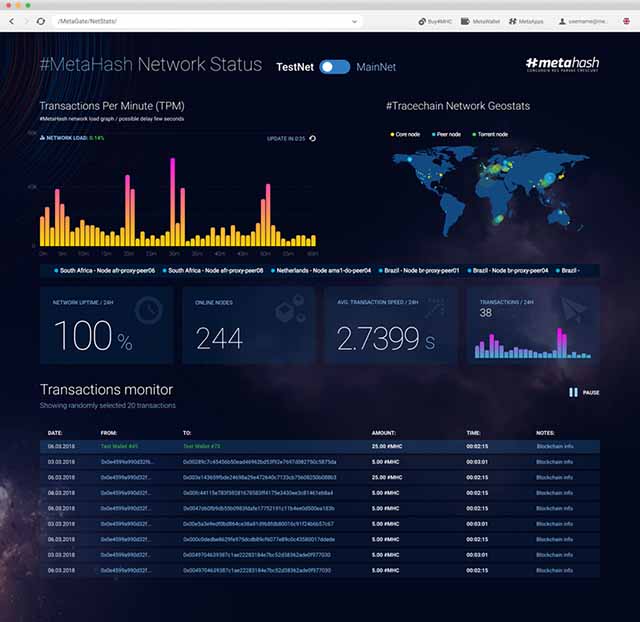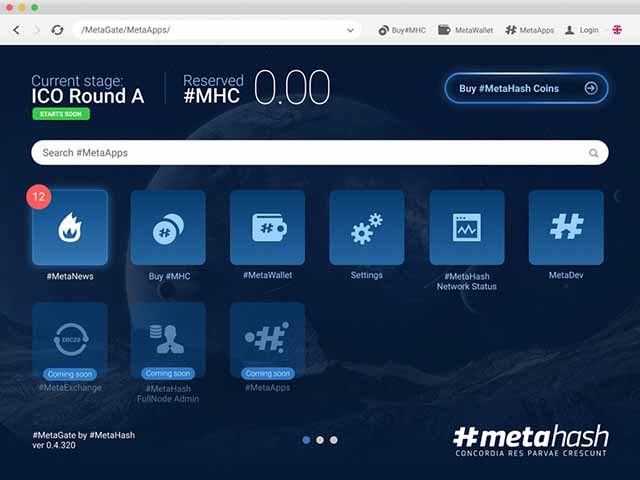#MetaHash, a leading blockchain-based digital asset exchange network and decentralized real-time application platform, announced the public debut of its #TraceChain protocol and #MetaGate browser.
Equivalent to Visa and Mastercard Systems but Tailored to Be Decentralized…
#TraceChain technology – which its creators termed as an alternative to blockchain – has a bandwidth which varies from 60,000 to 80,000 transactions per second, which is equivalent to Visa and MasterCard systems but tailored to be decentralized.

Moreover, the validation of more than 99% of transactions took only three seconds, compared to several minutes with existing popular blockchain systems. Interested parties can now download the free browser which is available for trial on Windows, OS X and Unix, with iOS and Android to follow shortly.
The main obstacle to the growth of the speed of all decentralized ledgers (both DAG and blockchain) is the synchronization of data (especially between different continents). Looking at the architecture of the decentralized ledger from a different angle, #MetaHash offered a solution whereby the maximum possible network synchronization speed is achieved while using the standardized speed for most computers on the Internet bandwidth of 100 MBit/s. A series of tests by dedicated developers produced a multi-layered architecture by #MetaHash for the purpose of using standard computers for the network with the simultaneous maximum synchronization speed and verification of the data.
A high-performance network library, created by #MetaHash, has become the basis for building a network of the future.
#MetaHash has once been termed as a “very ambitious project”, but it has kept abreast of its development roadmap, trailblazing the direction for the cryptocurrency community to branch off from older, existing blockchains that are “stagnating due to low scalability and a lack of smart contract or DApp functionality”. With the public debut of #TraceChain protocol and #MetaGate browser, crypto experts are anticipating that #MetaHash will hurdle a major uphill battle of widespread adoption.
Let’s take a hard look at how the four components of the #MetaHash system form a single, synergistic entity:
#TraceChain
An automatic self-learning signal routing protocol, #TraceChain can process more than 50,000 transactions per second. It grows as more nodes with higher bandwidth are added to the network, forming its core and improving the reliability of additional #DataChains needed for running applications.
#MetaHashCoin (#MHC)
#MHC is a digital asset that acts as means of payment in the network. #MHC provides consensus and regulates self-financing of network development. Digital assets in the form of tokens in the #MetaHash network can be exchanged within the network, and also converted into tokens of other networks, including Bitcoin and Ethereum, and back.
#MetaApps
The core code of #MetaApps optimizes the location of application copies based on required resources and financial motivation of the owners of nodes connected to the network. Any developer can create and publish an application in #MetaApps, while #MetaHashCoin holders decide via open vote whether or not to approve updates or changes, reflecting the universal values of all network members.
#MetaGate
#MetaGate is a browser for decentralized applications that includes a multi-currency wallet. Via its open source interface, third-party developers can use #MetaGate code to embed #MetaApps and #TraceChain/blockchain features into various applications and browsers.
The trial period, expected to run through Q2 2018, leverages more than 200 temporary servers throughout the world, that will be replaced by token owner nodes once the network is fully functional. Only then can it be said with confidence, “#MetaHash presents a revolution in payment systems and in decentralized data storage.”

#MetaHash project’s advisory board includes well-known professionals from crypto and IT industry: Brock Pierce, Scott Walker, Liu Jubo – just to name a few. For more information and to experience the trial, please visit metahash.org. You can also check the Company’s Medium blog, Facebook page, and Telegram chat.
Images courtesy of #MetaHash
The post #MetaHash: A Revolutionary Payment and Decentralized Data Storage System? appeared first on Bitcoinist.com.
Powered by WPeMatico
